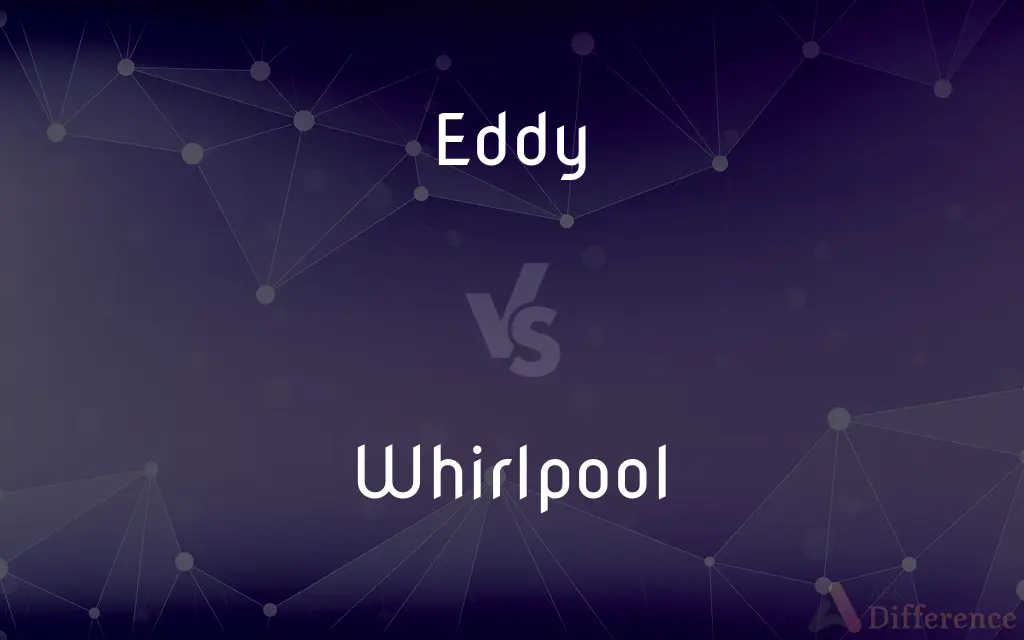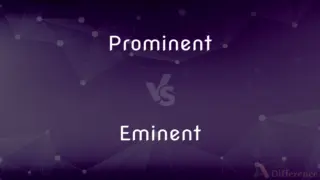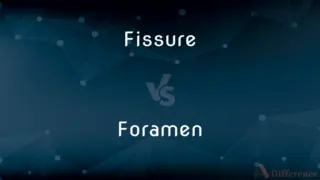Eddy vs. Whirlpool — What's the Difference?
By Tayyaba Rehman & Urooj Arif — Updated on March 28, 2024
Eddy is a small circular current of water, whereas whirlpool is a powerful, swirling body of water often created by ocean tides or river flows.

Difference Between Eddy and Whirlpool
Table of Contents
ADVERTISEMENT
Key Differences
An eddy is typically a minor swirl of water that can form in any body of water, including rivers, lakes, and oceans, often as a result of obstacles in the water's path like rocks or the structure of the waterway itself. These circular movements of water are relatively gentle and can be seen in many natural settings. Whirlpools, on the other hand, are larger and more powerful swirling currents that can be dangerous. They are formed by the meeting of conflicting currents or when water rapidly drains through a narrow space.
Eddies are common in rivers where the flow of water is interrupted by objects, creating a reverse flow that swirls back against the main current. They can serve as resting spots for paddlers in kayaks or canoes because they are areas of relatively calm water. Whirlpools occur in seas or rivers, often at narrows or where currents meet, and their size and strength can vary from small and harmless to large and perilous, such as the famous Saltstraumen in Norway.
The formation of an eddy is a natural process that helps to aerate the water, benefiting aquatic life by distributing oxygen and nutrients. Whirlpools can also have an ecological impact, but their powerful currents are more known for their ability to draw in objects, including boats and swimmers, posing a greater risk to safety.
While eddies can be easily observed in many water bodies and are often considered benign, whirlpools have captured the human imagination throughout history, featuring in myths and legends as formidable forces of nature. Their size can range from a few feet across to several miles in diameter, and they may last for short periods or for an extended duration, depending on the conditions that create them.
The understanding and observation of both phenomena are important for navigation and safety in water bodies. Eddies can offer safe havens or assist in water navigation, while understanding the location and behavior of whirlpools is crucial for avoiding potential dangers during maritime journeys.
ADVERTISEMENT
Comparison Chart
Definition
A small circular movement of water.
A powerful, swirling current of water.
Size
Generally small and gentle.
Can range from small to very large and dangerous.
Formation
Often formed by obstacles in water.
Caused by conflicting currents or rapid draining.
Impact
Can aerate water, benefiting aquatic life.
Can draw in objects and pose risks to safety.
Navigation
Can provide rest spots for paddlers.
Important to understand and avoid for safety.
Compare with Definitions
Eddy
Can be observed in many natural settings.
Observing eddies can help understand water currents.
Whirlpool
Featured in myths and legends.
Ancient mariners feared whirlpools, believing them to be monstrous entities.
Eddy
Circular movement in water bodies.
Fish often swim in eddies to conserve energy.
Whirlpool
A powerful, swirling current.
The boat navigated carefully to avoid the large whirlpool.
Eddy
A minor swirl of water behind an obstacle.
Kayakers use eddies behind rocks to rest.
Whirlpool
Formed by conflicting currents.
Whirlpools at sea are often created by tidal flows.
Eddy
Generally benign and safe.
Eddies offer safe spots in otherwise strong river currents.
Whirlpool
Requires caution for navigators.
Mariners study water charts to avoid known whirlpool locations.
Eddy
A result of disrupted water flow.
Eddies can form at the edges of fast-flowing rivers.
Whirlpool
Can vary in size and danger.
Small whirlpools pose little danger, unlike their larger counterparts.
Eddy
A circular movement of water causing a small whirlpool
Eddies of controversy swirled around his theories
The current was forming foam-lipped eddies along the bank
Whirlpool
A whirlpool is a body of rotating water produced by opposing currents or a current running into an obstacle. Small whirlpools form when a bath or a sink is draining.
Eddy
(of water, air, or smoke) move in a circular way
The mists from the river eddied round the banks
Whirlpool
A rapidly rotating current of water; a vortex.
Eddy
A current, as of water or air, moving contrary to the direction of the main current, especially in a circular motion.
Whirlpool
Something, such as a situation, that is confusing or tumultuous and is easy to be drawn into or difficult to get out of
Was sucked into a whirlpool of despair.
Eddy
A drift or tendency that is counter to or separate from a main current, as of opinion, tradition, or history.
Whirlpool
A bathtub or pool having jets of warm water that can be directed toward a body part as for therapeutic purposes.
Eddy
To move in or as if in an eddy or eddies
"The conversation among the new elite eddied around me" (Molly Peacock).
Whirlpool
A swirling body of water.
A whirlpool is an instance of a vortex produced by ocean tides, or by a hole underneath where the water would drain out, such as in a bathtub.
Eddy
A current of air or water running back, or in an opposite direction to the main current.
Whirlpool
A hot tub, jacuzzi.
Eddy
A circular current; a whirlpool.
Whirlpool
Turmoil, or agitated excitement.
Eddy
(slang) A marijuana edible.
Whirlpool
(intransitive) To spin or swirl like the water in a whirlpool.
Eddy
(intransitive) To form an eddy; to move in, or as if in, an eddy; to move in a circle.
Whirlpool
An eddy or vortex of water; a place in a body of water where the water moves round in a circle so as to produce a depression or cavity in the center, into which floating objects may be drawn; any body of water having a more or less circular motion caused by its flowing in an irregular channel, by the coming together of opposing currents, or the like.
Eddy
A current of air or water running back, or in a direction contrary to the main current.
Whirlpool
A sea monster of the whale kind.
The Indian Sea breedeth the most and the biggest fishes that are; among which the whales and whirlpools, called "balænæ," take up in length as much as four . . . arpents of land.
Eddy
A current of water or air moving in a circular direction; a whirlpool.
And smiling eddies dimpled on the main.
Wheel through the air, in circling eddies play.
Whirlpool
A powerful circular current of water (usually the resulting of conflicting tides)
Eddy
To move as an eddy, or as in an eddy; to move in a circle.
Eddying round and round they sink.
Whirlpool
Flow in a circular current, of liquids
Eddy
To collect as into an eddy.
The circling mountains eddy inFrom the bare wild the dissipated storm.
Eddy
Founder of Christian Science in 1866 (1821-1910)
Eddy
A miniature whirlpool or whirlwind resulting when the current of a fluid doubles back on itself
Eddy
Flow in a circular current, of liquids
Common Curiosities
Can eddies be dangerous?
Generally, eddies are not dangerous and can provide calm spots in moving water, although they can be disorienting.
What is a whirlpool?
A whirlpool is a powerful, swirling body of water, often formed where currents meet or water drains through a narrow space.
How are eddies formed?
Eddies form when water flows around obstacles, creating a circular movement in the water behind the obstruction.
How can understanding eddies and whirlpools improve water navigation?
Knowledge of these water currents helps navigators avoid potential dangers and utilize safe spots.
What should one do if caught in a whirlpool?
It's crucial to remain calm and paddle or swim perpendicular to the current to escape the whirlpool's pull.
Are all whirlpools large and fearsome?
No, whirlpools vary in size and strength; not all are large or dangerous.
What is an eddy?
An eddy is a small, circular current of water caused by the flow encountering an obstacle.
Why are whirlpools considered dangerous?
Whirlpools can be dangerous due to their strong currents capable of drawing in and trapping objects, including boats and swimmers.
Do eddies only occur in natural water bodies?
No, eddies can also form in man-made water systems wherever water flows around obstacles.
What causes whirlpools to form?
Whirlpools form due to the meeting of conflicting currents or the rapid draining of water through a confined area.
Can whirlpools appear in any body of water?
While they can form in various water bodies, whirlpools are most common in seas, oceans, and rivers with strong currents.
Is it possible to predict the formation of whirlpools?
In some locations with known conditions for whirlpool formation, their occurrence can be predicted to some extent.
How do eddies benefit aquatic life?
Eddies can aerate water and distribute nutrients, benefiting fish and other aquatic organisms.
How do the sizes of eddies and whirlpools compare?
Eddies are usually smaller and less intense, while whirlpools can range from small to very large and powerful.
Have whirlpools been significant in history or culture?
Yes, whirlpools have often been featured in myths, legends, and maritime lore due to their powerful and mysterious nature.
Share Your Discovery

Previous Comparison
Prominent vs. Eminent
Next Comparison
Fissure vs. ForamenAuthor Spotlight
Written by
Tayyaba RehmanTayyaba Rehman is a distinguished writer, currently serving as a primary contributor to askdifference.com. As a researcher in semantics and etymology, Tayyaba's passion for the complexity of languages and their distinctions has found a perfect home on the platform. Tayyaba delves into the intricacies of language, distinguishing between commonly confused words and phrases, thereby providing clarity for readers worldwide.
Co-written by
Urooj ArifUrooj is a skilled content writer at Ask Difference, known for her exceptional ability to simplify complex topics into engaging and informative content. With a passion for research and a flair for clear, concise writing, she consistently delivers articles that resonate with our diverse audience.














































